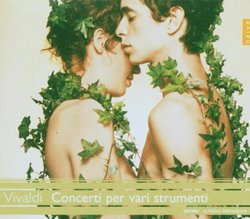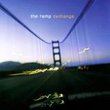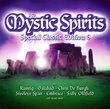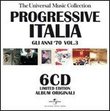| All Artists: Antonio Vivaldi, Alfredo Bernardini, Ensemble Zefiro, Orchestra Barocca Zefiro Title: Vivaldi: Concerti per vari strumenti (Vivaldi Edition) Members Wishing: 0 Total Copies: 0 Label: Naive Release Date: 5/17/2005 Genre: Classical Styles: Chamber Music, Forms & Genres, Concertos, Historical Periods, Baroque (c.1600-1750), Classical (c.1770-1830), Instruments, Reeds & Winds Number of Discs: 1 SwapaCD Credits: 1 UPC: 709861304097 |
Search - Antonio Vivaldi, Alfredo Bernardini, Ensemble Zefiro :: Vivaldi: Concerti per vari strumenti (Vivaldi Edition)
 | Antonio Vivaldi, Alfredo Bernardini, Ensemble Zefiro Vivaldi: Concerti per vari strumenti (Vivaldi Edition) Genre: Classical |
Larger Image |
CD DetailsSimilar CDs
|
CD ReviewsNot Antonio Vanilla John Willoughby | Amherst, MA | 09/24/2006 (5 out of 5 stars) "I'm not qualified to put more than my uneducated opinion here, but I can get rather indifferent to Vivaldi's sometimes predictable Concerto developments and forms - but not this disc. This gets played more than almost any other of my Vivaldi, except perhaps The English Consorts' 'Music for the Emperor' (and I do also like Biondi and Carmignola ripping their way happily through his concertos). I can't put it down to the performance or the pieces, but from the stoccato beginning through to the end, this has something a little different - interesting and rather striking progressions. Overall very satisfying. I feel like this is a distinct piece of Vivaldi rather than one of his variations on an earlier piece." Great Vivaldi Woodwind Collection Andrew Judkins | 08/16/2009 (4 out of 5 stars) "Aside from his monumental contribution to string repertoire, Vivaldi had an unparalleled interest in writing for woodwinds. In his time the oboe was second to only the violin in popularity as a solo instrument. However, Vivaldi also took to writing for the bassoon, flute, recorder and even clarinet. Many of these instruments were new or in their youth, such as the transverse flute and the clarinet. This exciting CD focuses on a wide variety of Vivaldi's concerto approaches for woodwinds. There are solo concerti for oboe and bassoon, concerti for four or more woodwinds and double concerti. This gives a wide perspective of Vivaldi's woodwind works that only omits his chamber concerti and sonatas. The recording is outstanding, not only for it's program, but for the enthusiasm of the performances. The soloists are excellent, with the oboes standing out while the bassoon playing is a bit dull at times compared with the work of Sergio Azzolini on Naive's concerti for oboe and bassoon release. The orchestra has a sharp edge and moving sense of rhythm. The balance suffers from a major loss of the bass instruments at various times throughout the recording which can be very annoying and taints an expert performance. The works included are: Concerto in C for 2 Oboes and 2 Clarinets RV 559. This work is one of two for this combination, the other ends this album. Vivaldi here shows his skills including four soloists while moving the material along. This concerto is perhaps my favorite between the two for this combination. It's outer movements display a keen wit. Notable features include a slow intro (a feature shared by RV 560) and a slow movement in which the woodwind soloists accompany themselves without aid--it is a movement of stunning beauty and simplicity. Concerto in A minor for Bassoon RV 497. This late work shows Vivaldi's penchant for surprise as he aged. The first movement starts out with a frantic blast, followed by a slower somber idea, then the ritornello is completed with more fury. Vivaldi writes with great daring for the bassoon and this work is no exception. Also notable is his late preference for a high degree of orchestral participation in the solos. The slow movement is a heavily ornamented delight. Concerto in D minor for 2 Violins 2 Recorders 2 Oboes and Bassoon RV 566. Some evidence suggests this work was written for Dresden elector's orchestra, including the witty rewrite of a Veracini movement (who was an Italian working in Dresden) for the first movement. Both these composers seemed to have had hot blood! For me the charm of the ancient sounding slow movement for 2 recorders and bassoon is the highlight. In the last movement Vivaldi stamps the work as his own with his famous chromatic suspension motif in the ritornello. Concerto in C for 2 Oboes RV 534. Vivaldi specifies this as concerto with two oboes not for two oboes. The passage work is based on short conversations between the soloists and the orchestra. While not totally symphonic the energy is from these dialogues, not from rhapsodic solo writing. Both outer movements sizzle while the slow movement brings to mind paddling on water. Concerto in B flat major for Violin and Oboe RV 548. This fine work shows off Vivaldi's sensitivity for different instruments. While the two instruments are in close imitation, they also follow their own strengths. The most obvious example is the slow movement in which the oboe plays a glassy melody while the violin accompanies with appregioes, providing the waves in the lagoon. Concerto in D minor for Oboe RV 454. This odd work was included in Vivaldi's opus 8. Its almost despondent mood goes against almost every oboe stereotype, excepting cantabile charm. The brutally off-beat opening ritornello with it's shocking chromatic runs is startling. The slow movement is classic cantabile while the last movement is a slightly disturbing country dance. Concerto in C major for 2 Oboes and 2 Clarinets RV 560. This work starts with a majestic intro that leads into a festive movement notable for the soloists adding parts during the ritornello. This work feels more ceremonial and majestic than RV 559, which seems more pastoral. The light slow movement omits the clarinets, while the last movement seems a bit tipsy. A great collection, one star off for bad balance muffling the bass line. " Great music Dominic Crapuchettes | Washington DC | 06/22/2009 (5 out of 5 stars) "It always makes me happy to find new music from my favorite composers that do not sounds like variations of other pieces that I already know. Much of Vivaldi sounds similar, but this CD has a lot of music that is unique and stunningly good. I have been very happy with this purchase."
|




